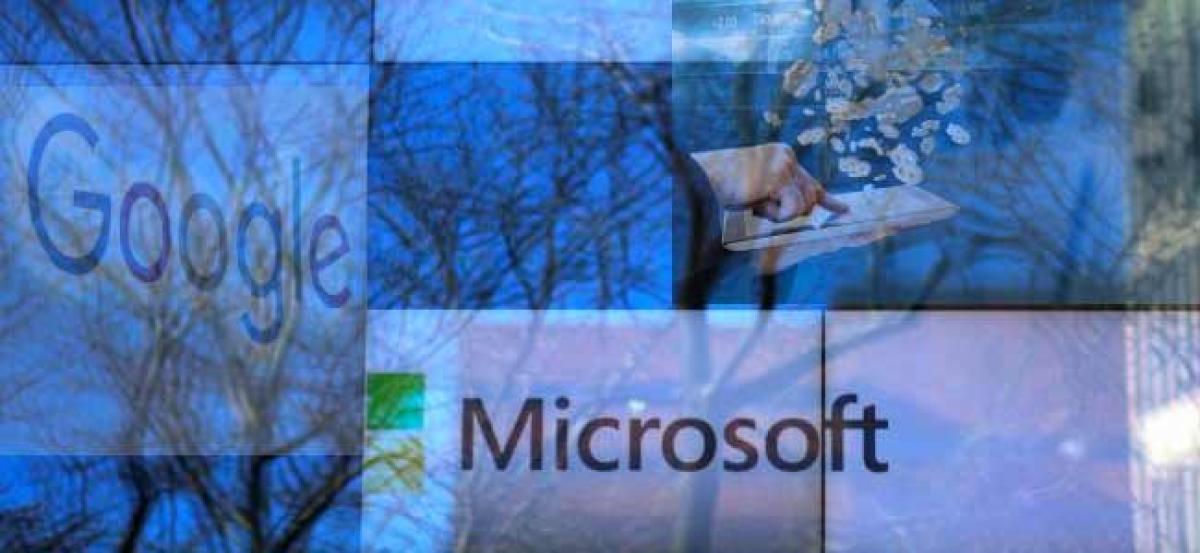Live
- First Impressions and Unboxing of the MacBook Pro M4: A Powerhouse for Professionals and Creators
- China Gears Up for Potential Trade War Amid Trump’s Tariff Threats
- Small Farmers Gain Less by Selling to Supermarkets: Study Reveals
- Why Despite the Controversy, America Is Anticipating the Mike Tyson vs. Jake Paul Fight
- Sanju Samson and Tilak Varma Shine: Record-Breaking Feats in 4th T20I Against South Africa
- India Urges $1.3 Trillion Annual Climate Support for Developing Nations
- Bad air: 106 shuttle buses, 60 extra Metro trips planned to make Delhiites give up cars
- WHO reports declining monkeypox cases in Congo
- CM Attends Kotideepotsavam on Kartika Purnima
- PKL Season 11: Raiding trio of Devank, Ayan, Sandeep help Patna Pirates rout Bengal Warriorz
Just In

Microsoft Corp\'s (MSFT.O) announcement of a suite of new education products on Tuesday shows the company\'s determination to reverse a major shift that has taken place in U.S. classrooms in recent years: for most educators and school districts, Google\'s Chromebook is now the computer of choice.
SAN FRANCISCO: Microsoft Corp's (MSFT.O) announcement of a suite of new education products on Tuesday shows the company's determination to reverse a major shift that has taken place in U.S. classrooms in recent years: for most educators and school districts, Google's Chromebook is now the computer of choice.
The Chromebook has gone from a standing start in 2011 to wild popularity in the market for education technology, which tech companies have traditionally viewed as a critical way to win over the next generation of users.
In 2016, mobile devices running Alphabet Inc's (GOOGL.O) Google’s Chrome operating system accounted for 58 percent of the U.S. market for primary and secondary schools, according to Futuresource Consulting.
The Microsoft products introduced Tuesday, including a new version of its Windows operating system, software to boost collaboration among students and a new Surface laptop, clearly show the influence of the Chromebook, industry watchers say.
“The success of the Chromebook has awakened sleeping giants,” said Tyler Bosmeny, CEO of Clever, an education technology company. “There’s so much investment into the space – it’s unlike anything I’ve ever seen.”
For years after the release of the Chromebook in 2011, Apple Inc (AAPL.O) and Microsoft stuck to their strategies of offering slightly modified and discounted versions of their products for educators.
But the Chromebook's low price--it starts at $149-- and easy management proved irresistible to many schools. Google also saw a key chance to expand its market share several years ago with the approach of an online testing mandate in the United States.
To capitalize on the opportunity, the company created a “test mode,” which restricts access to the rest of the web while students complete assessments, said Rajen Sheth, a senior director of product management at Google.
The preparations paid off: Sales of the Chromebook jumped tenfold between 2012 and 2013, Sheth said.
While Google manufactures some Chromebooks, the devices aimed at the education market are supplied by partners such as Samsung Electronics Co Ltd (005930.KS) and Acer Inc (2353.TW). The operating system is free for educators and hardware manufacturers, and Google sells schools an education package including device management and support for a $30 fee.
For Microsoft, Tuesday's event was the culmination of a campaign to emulate key aspects of the Chromebook strategy, said Mike Fisher, associate director for the education division at Futuresource Consulting.
Microsoft's hardware partners are now selling hybrid tablet-laptop devices based on the Surface design starting at $189. Microsoft executives boasted that the operating system announced Tuesday boots up rapidly, a hallmark of the Chromebook.
The company also introduced a new code-builder addition to its Minecraft education edition to help students learn coding skills through the popular game.
For Microsoft, the test will be how easily it can explain its offering to educators, Fisher said.
“The Google education ecosystem is quite straightforward," he said. "With Microsoft, there’s a lot of moving parts."
Microsoft declined to comment.
Apple, for its part, has lowered the price of the iPad to $299 for education customers and made it possible for students to share devices, in addition to simplifying management.
“It’s about trying to reach every teacher and every student,” said Susan Prescott, a vice president of product management and marketing at Apple.
Despite Google’s U.S. dominance, its position is weaker in classrooms overseas, where many markets have not yet seen an impetus to embrace technology en masse, said Fisher of Futuresource Consulting.
In 2016, devices running Android and Chrome made up 23 percent of the mobile market outside the United States, compared with 65 percent for Microsoft’s Windows, according to Futuresource.

© 2024 Hyderabad Media House Limited/The Hans India. All rights reserved. Powered by hocalwire.com







